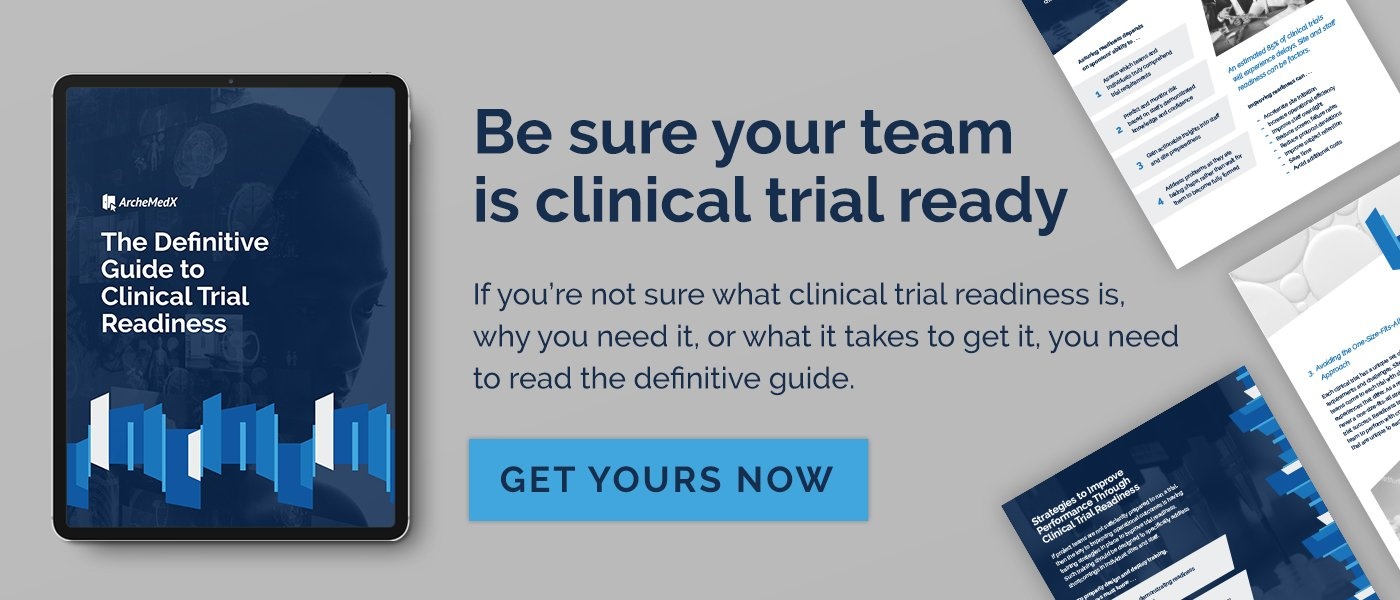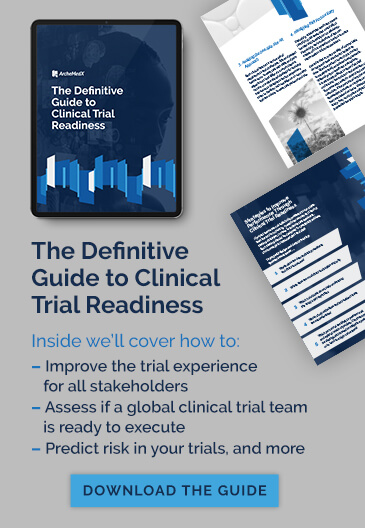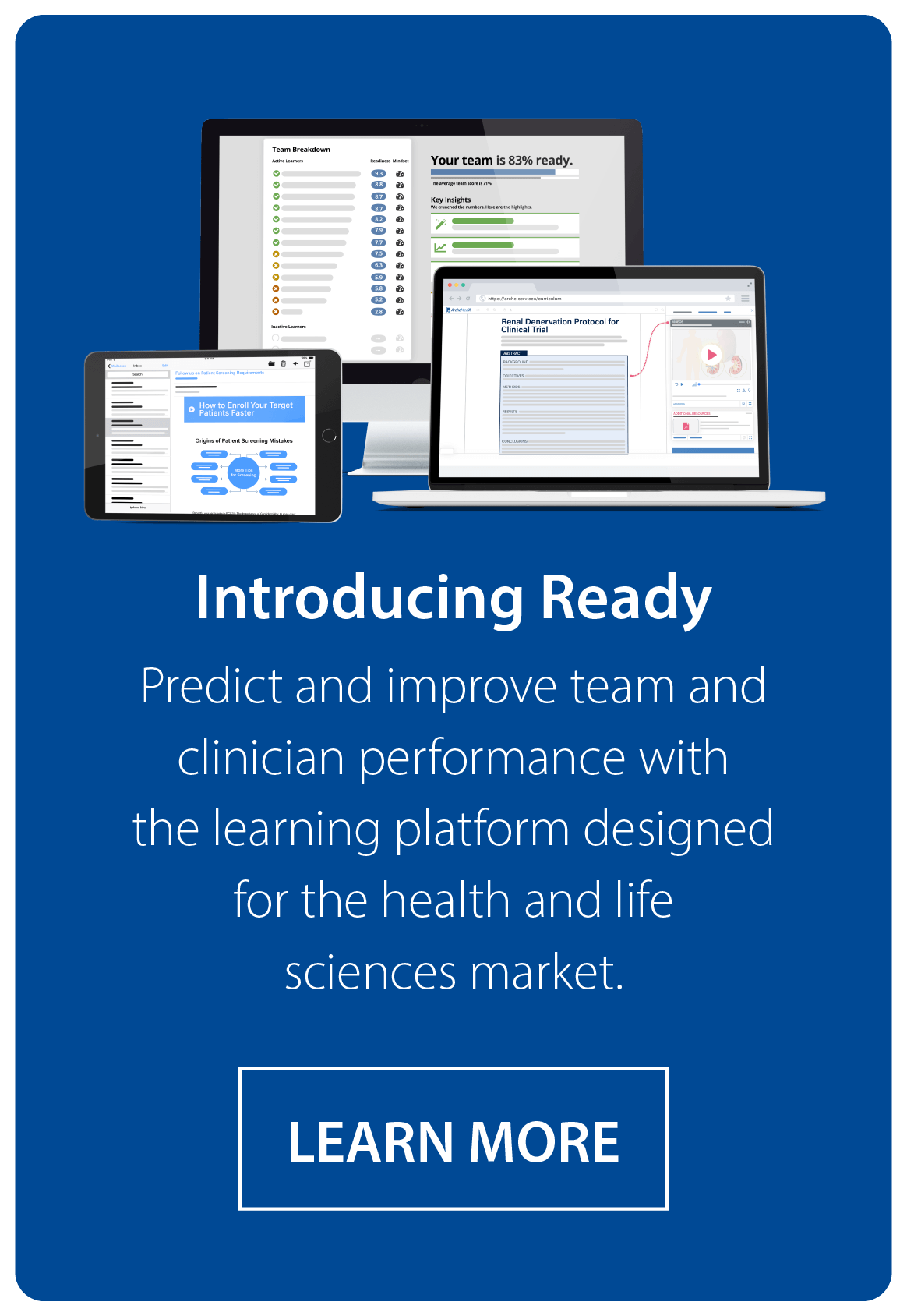When was the last time you conducted a face-to-face clinical trial site training for anyone? More importantly, when do you think you will do it again?
That’s truly the question in clinical operations today – when will we resume our “normal” activities? Or will we? And if we don’t, what does that look like?
For many, it’s an opportunity to investigate the maximum use of virtual tools. And content delivery – particularly training – is primed for this experiment. But if your existing content isn’t engaging enough, you’re much more likely to lose your audience in a virtual setting.
Want to ensure success? Check out these tips to ensure you deliver a premium virtual experience – and prove the effectiveness afterwards.
Tip #1: Don’t start with the manual – start with objectives.
This sounds counter-intuitive. Why not start with the content and resources you already have?
The problem with your clinical trial site training content is that it was created for a scenario where people are in person with an instructor. In the best circumstances, personnel are well caffeinated, and under the spell of the live presenter, hanging on every word. In the worst scenario, they can be brought back into the moment if they zone out.
Don’t throw the manual away, but start with the objectives you need to achieve. Some quick examples include:
- Personnel must be able to disqualify a subject that doesn’t meet criteria.
- Personnel must understand the importance of the special sample collection.
- Personnel must be capable of collecting our required data completely.
By starting with the objectives you wish to achieve, you can refocus every additional step you take to get there.
And being able to check off specific objectives feels much more powerful than just checking off “completed training,” doesn’t it?
Tip #2: With objectives in mind…create a clinical trial site training curriculum.
Now it’s time to break out your manual, 400 page slide deck, folder of PDFs and start cutting and pasting. But this early in the process, your goal should be to see how much you can reuse to reduce your workload, not finish the work.
That’s because now is the time to think big picture. Create an outline – and tie each step in your outline back to your objectives. Planning a unit to focus on the patient criteria? Awesome! That ties directly to the objective we set with Tip #1.
Check your outline for opportunities to improve engagement, retention, and the most important for a clinical trial…application to a real world scenario.
Protocols are rarely optimized for staff, doctor, or personnel consumption. Where are there areas that could be easily overlooked or missed altogether? Where do your audience members likely need more detail or more scientific background? Where could you add some supplementary materials?
Mark those areas as opportunities for some of the next tips.
Tip #3: Encourage engagement by using many different media types.
“Death by Powerpoint…” This has long been the preferred approach for most presenters. And it can be painful enough for during an in-person meeting.
However, try this approach virtually, and you’ll not only lose attendees to multi-tasking, but you’ll reduce their willingness to attend virtual activities in the future.
Remember Tip #2? For those risk areas you found in your outline, this is a perfect opportunity to now use different media to call out those specific things you want to emphasize. What sorts of media, you ask?
Charts, graphs, and simple images are all effective to engage people visually with concepts you’ve included already in written copy, and they can all be created by anyone with a computer and the Internet.
Video is also extremely powerful for keeping someone engaged. Today, you can quickly produce a video from a powerpoint, with voiceover or even music to break up the viewing experience.
Tip #4: Do NOT take all the work on yourself.
No, you don’t need a team to do this. You can encourage curiosity by adding additional, optional resources to your curriculum. It’s likely you’ve used some in creating your clinical trial site training content already – so share what you already pulled!
Has there been a trial similar to this one that may have published results? Are there documents from Phase I or II that could be valuable?
Seek out other resources from other contributors to help build out a library of resources, and link to them or include them as additional, optional reading/viewing content. With additional learning opportunities, you can engage those who may feel already prepared with your primary content, but are interested in checking out something additional.

Tip #5: Encourage application by creating scenarios.
The great thing about engaging people is that they’re more likely to retain the information you’re putting in front of them. A video or well-designed image will engrain a point into the staff member’s memory.
But remember – we don’t just want to check the box that we “completed clinical trial site training.” We want to meet specific objectives!
So use a technique that many large organizations are using for their corporate trainings – creating real world scenarios or vignettes. You probably do case studies or an exercise in a large group at investigator meetings today. Virtually, though, your team must work on their own to complete the activity…which will attach meaning to the content you’ve provided them.
Make your scenarios realistic, make them a bit uncomfortable, and make them come to a decision point to encourage critical thinking. After all, these are real people that will have to deal with real issues and real consequences during a trial.
Returning back to the example of eliminating a patient based on eligibility, design a scenario where a patient meets all initial eligibility criteria, but barely misses on exclusion criteria. Find something that is likely to provoke thought in your team.
Tip #6: Encourage retention by planning a follow up plan.
It’s well-documented that humans retain information better when it’s repeated. Often in content, we do that well – revisiting a point numerous times.
But once that training, or meeting, or conversation is over, how quickly will your staff forget the critical points you delivered? Odds are that your staff will forget 70% of what they learned in 24 hours. This is well-documented and known as the Forgetting Curve. And – unfortunately – it’s happening with the content you deliver today in traditional formats.
So now you have a major opportunity to help address this problem. Find ways to encourage your team to recall your content again and again.
Perhaps it’s a weekly email with a scenario, asking them to apply it. Or a short poll you send asking for responses each week to engage their memory.
Plan this as part of your curriculum. Then find a way to automate it. (Ready can help.)
Tip #7: Commit to measuring against your objectives.
One of the reasons you started with objectives, not your existing content, was because you defined what you wanted to achieve. Now you can define how you’ll prove you have achieved these objectives.
We blog frequently about clinical trial readiness, and a large part of readiness is measurement – that is, understanding how capable and confident personnel are with applying your content. Some examples we’ve seen include:
- Did the staff member disqualify the subjects in our scenario correctly?
- Could the staff list all of the special sample collection requirements for this trial?
- In a data collection scenario, was every data point collected completely?
These are just a few very simple ways to tie a measurement back to your initial objectives, and show evidence that your curriculum is ensuring clinical trial readiness.
Bonus Tip: Use Ready by ArcheMedX to deliver, automate, and measure your content – on-demand.
From defining objectives to measuring completion, Ready is a comprehensive platform that offers you a better way to understand and demonstrate which investigators, sites, personnel, and trial team members are truly ready and equipped to perform a study effectively. Learn more about Ready, and how it can help you implement these tips here.





